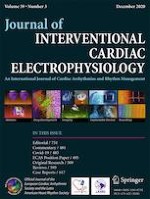Erschienen in:

18.12.2019 | Atrioventricular Block
Acute and long-term outcomes of left-sided atrioventricular node ablation in patients with atrial fibrillation
verfasst von:
Hikmet Yorgun, Uğur Canpolat, Yusuf Ziya Şener, Metin Okşul, Fatih Akkaya, Ahmet Hakan Ateş, Kudret Aytemir
Erschienen in:
Journal of Interventional Cardiac Electrophysiology
|
Ausgabe 3/2020
Einloggen, um Zugang zu erhalten
Abstract
Purpose
To present our experience regarding acute and long-term outcomes of left-sided atrioventricular node (AVN) ablation in patients with atrial fibrillation (AF).
Methods
A total of 47 patients with AF in whom left-sided AVN ablation via retroaortic approach as a first-line approach were enrolled in this retrospective study. Indications for AVN ablation were high ventricular rate refractory to medical therapy, inappropriate implantable cardioverter defibrillator (ICD) shocks, or loss of cardiac resynchronization therapy (CRT) pacing. Both acute and long-term outcomes were assessed for all participants.
Results
Left-sided AVN ablation was successfully performed in 46/47 (98%) patients without any procedural complication. In the remaining 1 patient (2%), right-sided AVN ablation was performed. No mortality was observed within 30 days of the procedure. Upgrade to CRT was performed in 9 (19%) of the patients. During the median 22.5 months of follow-up, all-cause mortality was 25%. Device interrogations on the last clinical visit revealed complete AV block and intrinsic ventricular rate of < 40 bpm in all patients.
Conclusion
Left-sided AVN ablation is a safe and effective procedure without recurrence during long-term follow-up.











